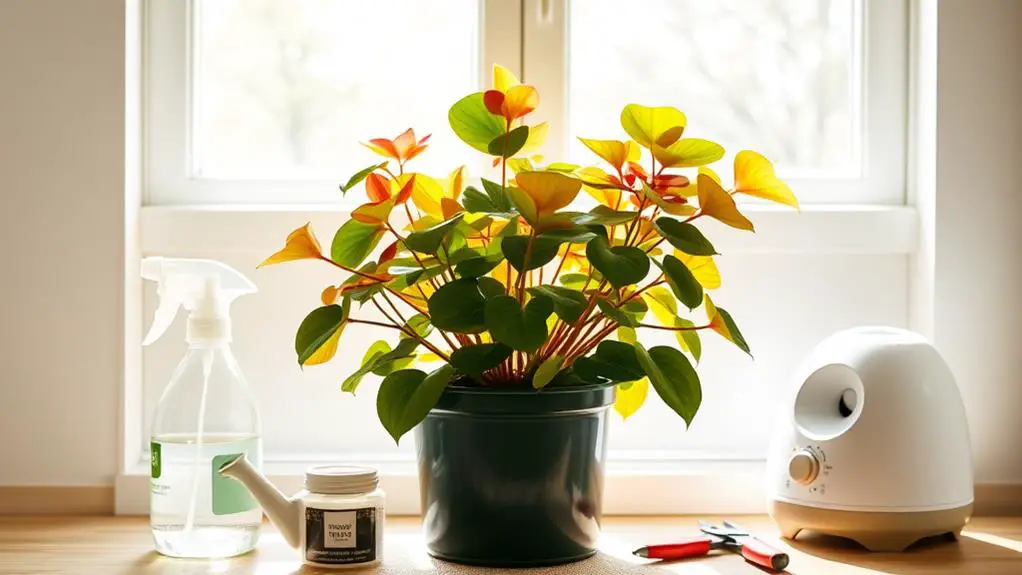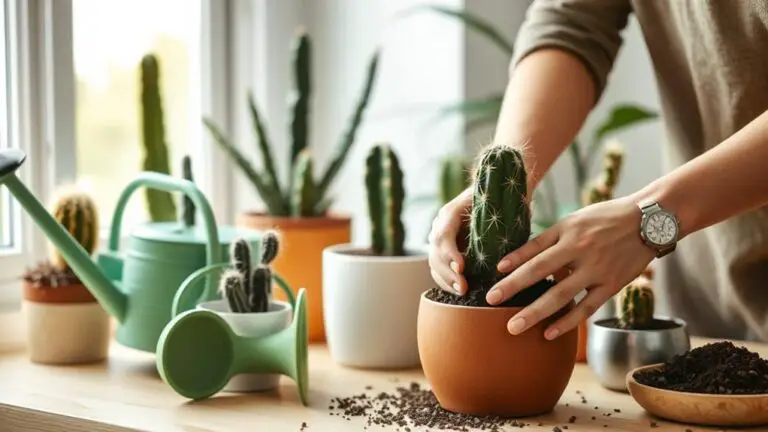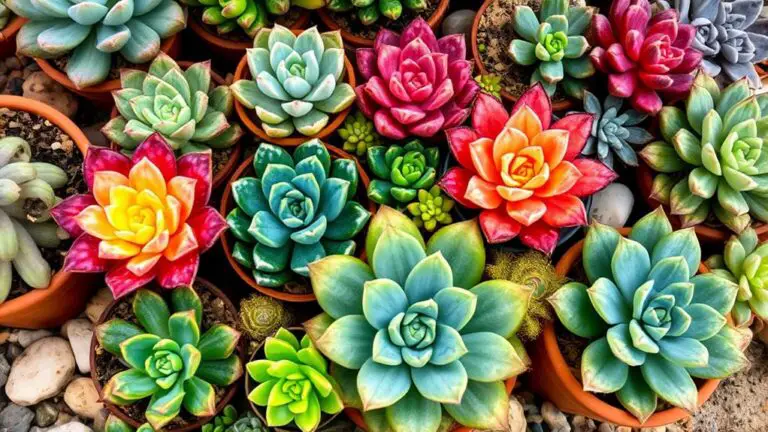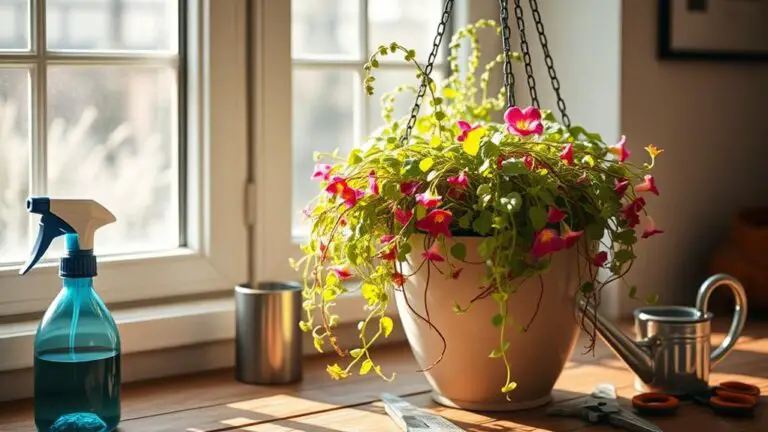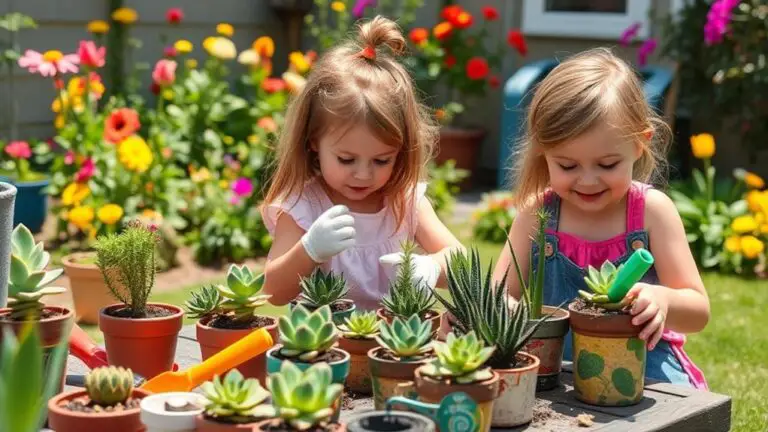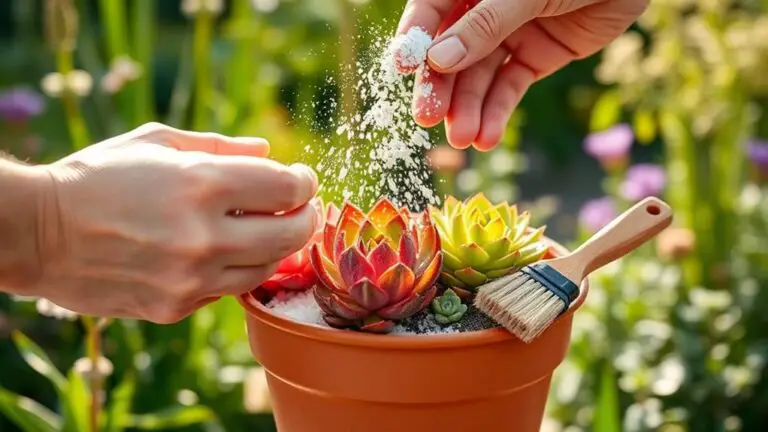7 Essential Steps to Care for Your Peperomia Hope
Caring for your Peperomia Hope doesn't have to be complicated, but it does require some attention to detail. You'll need to guarantee it gets the right amount of light, water, and nutrients to thrive. Start by placing it in a spot where it receives bright, indirect light for about 6-8 hours each day. But that's just scratching the surface. Curious about how to manage its watering schedule or the best way to handle pests? Let's look at each step to make certain your plant stays healthy and vibrant.
Light Requirements

When it comes to light requirements, Peperomia Hope thrives in bright, indirect light. To keep your plant healthy, place it about 1 meter away from south or west-facing windows. This setup guarantees it gets enough bright light without the risk of leaf burn.
Direct sunlight can cause dull, washed-out leaves and overall plant stress, so it's best to avoid it.
Peperomia Hope can adapt to lower light conditions, but you might notice leggy growth and less vibrant foliage. It's not ideal but manageable if you don't have a bright spot. For best light conditions, aim for 6-8 hours of bright light daily. This helps maintain its vibrant appearance and overall plant health.
When changing your plant's location, gradually acclimate it to the new lighting environment. Sudden changes can shock the plant, causing stress and poor growth.
Watering Schedule
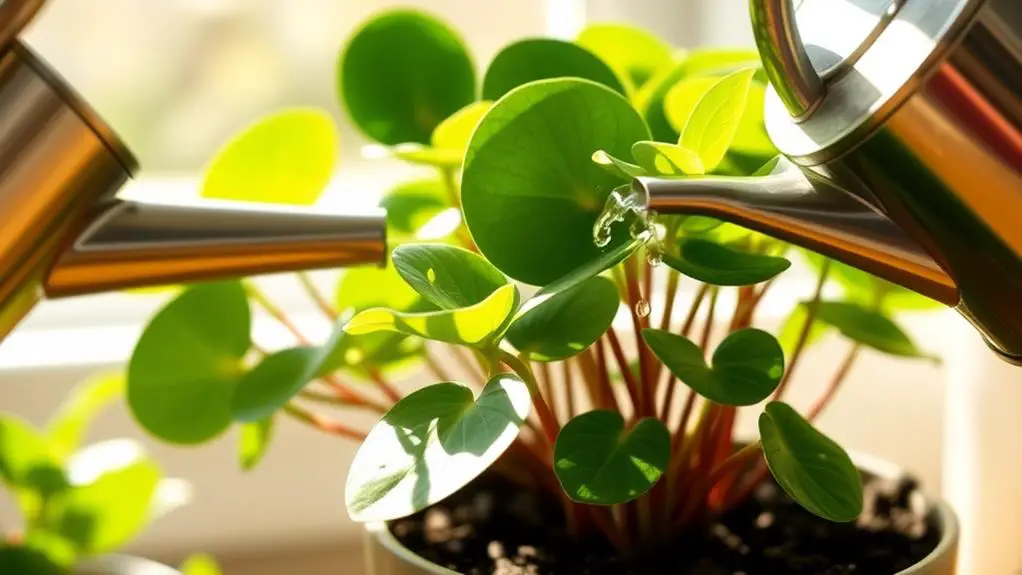
Caring for your Peperomia Hope involves establishing a consistent watering schedule to keep it thriving. Water your Peperomia when the top inch to three inches of soil are dry. Typically, this means watering every one to two weeks during the growing season and less often in winter.
Be certain to check the soil moisture regularly to avoid overwatering, which can lead to root rot.
It's essential that your pot has drainage holes to let excess water escape. This prevents water from accumulating at the bottom, which can harm your plant.
When you water Peperomia, use room temperature water and apply it directly to the soil. Avoid getting water on the leaves, as this can cause fungal problems.
Keep an eye out for signs of overwatering. Drooping leaves and soft stems are clear indicators that you need to adjust your watering schedule.
During periods of low humidity, you can help maintain consistent moisture by placing the pot on a water-filled tray or misting the plant. This guarantees your plant gets the humidity it needs without drenching the soil.
Soil and Fertilization
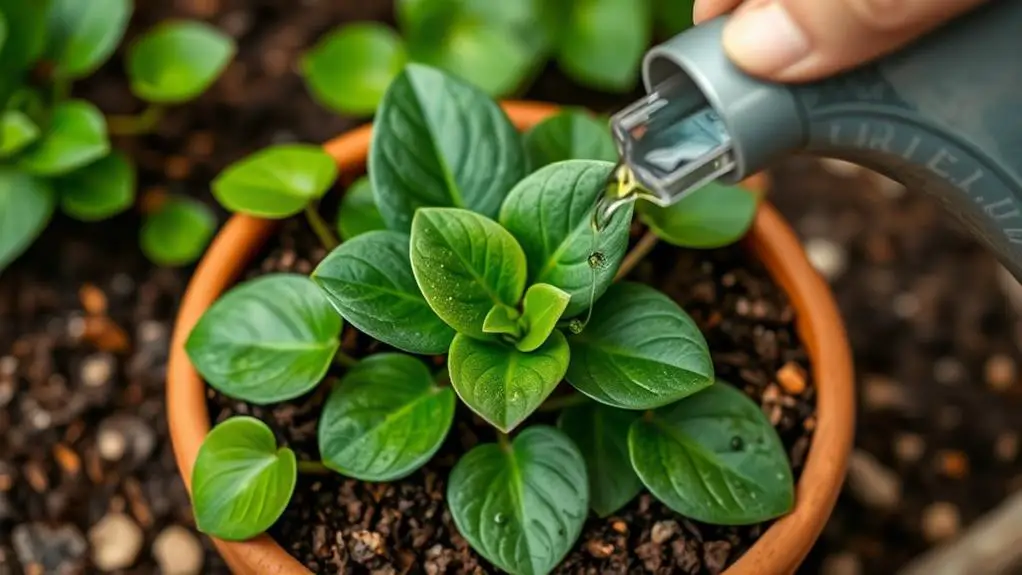
To keep your Peperomia Hope thriving, start with a well-draining potting mix that includes peat moss, perlite, or coarse sand.
Stick to a balanced, diluted organic fertilizer every 4-6 weeks during spring and summer, but skip it in fall and winter when the plant's growth slows down.
Remember to let the soil dry out slightly between waterings to avoid root rot and other common soil issues.
Ideal Soil Composition
Achieving the perfect soil composition for Peperomia Hope hinges on ensuring excellent drainage and proper aeration. Peperomia thrives in a well-draining potting mix, which should include a blend of peat moss, perlite, and coarse sand. This combination helps prevent root rot by allowing water to flow through the soil easily while maintaining the right amount of moisture.
The soil's pH level is also important. Aim for a slightly acidic range of 6.0 to 6.5 to promote healthy growth. It's vital to let the soil dry out a bit between waterings. Peperomia prefers slightly moist conditions, but overwatering can be a problem.
When it comes to fertilization, remember to keep things balanced. Every 4-6 weeks during the growing season, use a water-soluble fertilizer, but dilute it to avoid leaf burn.
Repotting should be done every 1-2 years or when your plant seems root-bound. This process refreshes the soil nutrients, giving your Peperomia a healthy boost.
Proper Fertilization Schedule
Maintaining the right soil composition is just one part of growing a healthy Peperomia Hope; equally important is a proper fertilization schedule. To guarantee your plant thrives, fertilize during the growing season, which is in spring and summer.
Every 4-6 weeks, use a diluted, balanced water-soluble fertilizer to promote healthy growth. A fertilizer with an N-P-K ratio around 10-10-10 works well, providing a balanced nutrient supply without overloading the plant.
Before fertilizing, make sure the soil is slightly moist. This helps prevent fertilizer burn on the roots and leaves.
Avoid fertilizing in winter because the plant's growth slows down, and it needs less nutrition during dormancy.
Keep an eye out for signs of nutrient deficiency, like yellowing leaves. This could indicate your Peperomia Hope needs extra nutrients. If you notice this, consider adjusting your fertilization schedule.
Common Soil Issues
Peperomia Hope faces several common soil issues that can hinder its growth and significance. Ensuring your Peperomia Hope thrives involves understanding and managing these soil issues effectively.
First, root rot is a frequent problem, often caused by overwatering. To prevent this, use well-draining soil and make sure the pot has good drainage.
Second, soil compaction can restrict root growth and reduce oxygen flow. A suitable potting mix with peat moss and perlite or coarse sand will help avoid this issue.
Third, monitoring moisture levels is essential. Overwatering can lead to leaf curling and yellowing, so let the soil dry out between waterings, especially in winter.
Finally, fertilize your Peperomia Hope with a balanced, water-soluble fertilizer every 4-6 weeks during the growing season. Over-fertilization can cause leaf burn, so be cautious.
Here's a quick checklist to help you manage common soil issues:
- Use well-draining soil – prevents root rot and compaction.
- Monitor moisture levels – avoid overwatering and let soil dry out.
- Choose the right potting mix – includes peat moss and perlite or coarse sand.
- Fertilize properly – balanced, water-soluble fertilizer every 4-6 weeks.
Temperature and Humidity
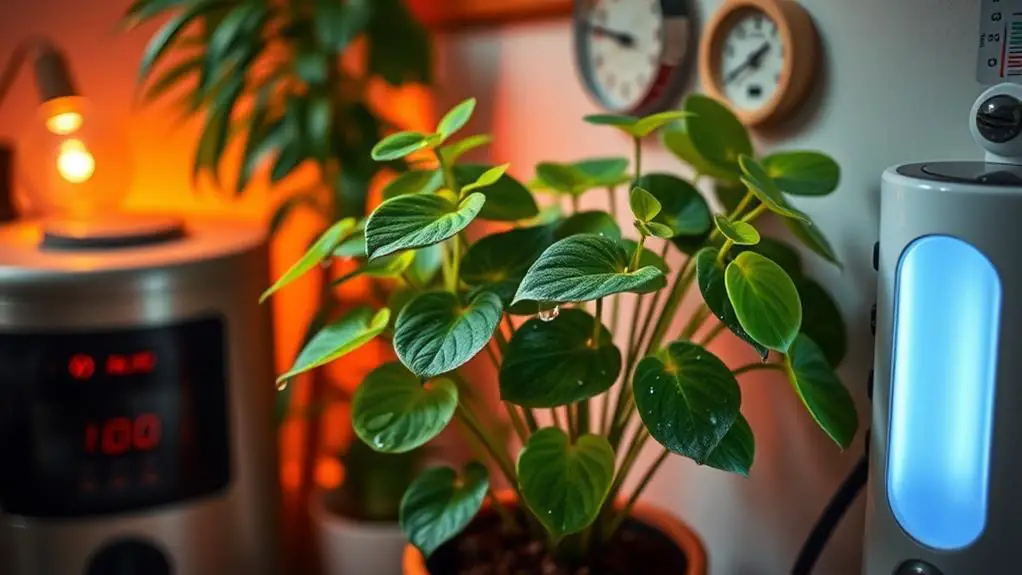
When caring for Peperomia Hope, keep your plant in a comfortable range of 65°F to 80°F and away from temperatures below 50°F to prevent stress.
It thrives in moderate to high humidity, so regular misting or using a humidifier can help.
Avoid drafts and extreme temperature changes to keep your plant healthy and happy.
Optimal Temperature Range
A essential aspect of keeping your Peperomia Hope healthy is guaranteeing it stays within its ideal temperature range of 65°F to 80°F (18°C to 27°C). This range is perfect for typical indoor environments and helps your plant thrive.
Peperomia Hope is sensitive to temperatures below 50°F (10°C), which can cause stress and damage. To keep your plant happy, avoid areas with drafts or extreme heat.
Here are some tips to maintain the ideal temperature:
- Avoid Drafts: Place your Peperomia Hope away from vents and windows where drafts are common.
- Consistent Exposure: Make sure it's not exposed to fluctuating temperatures. Steady conditions are best.
- Monitor Indoor Environments: Use a thermometer to keep track of the room's temperature, making sure it stays within the ideal range.
- Utilize Humidity: While temperature is significant, remember that Peperomia Hope also loves moderate to high humidity levels, between 40% and 60%.
Because of its tropical nature, your Peperomia Hope will flourish in a warm, stable environment.
If your indoor humidity is low, consider using a humidifier to support ideal growth. By providing consistent care, you'll see your Peperomia Hope grow beautifully.
Humidity Maintenance Tips
Maintaining the right temperature isn't the only factor in guaranteeing your Peperomia Hope thrives. Humidity plays an essential role too. Your plant loves moderate to high humidity levels, ideally between 40% to 60%. You can achieve this by misting the leaves regularly, but be careful not to overdo it to avoid leaf rot.
Using a humidifier is another excellent way to maintain ideal humidity levels. Grouping your Peperomia Hope with other plants can also help. Plants release moisture through a process called transpiration, collectively increasing the humidity around them.
Placing your Peperomia in naturally humid areas like kitchens or bathrooms can work wonders for its health. Additionally, you can use humidity trays. Fill a tray with water and pebbles, and place the plant on top. As the water evaporates, it creates a humid micro-environment.
Remember to monitor humidity levels regularly, especially during dry seasons. Low humidity can stress your plant, affecting its overall health. By keeping an eye on these levels, you can guarantee your Peperomia Hope remains vibrant and stress-free.
With these tips, you'll create the perfect environment for your plant to flourish!
Avoid Extreme Conditions
Extreme conditions can be a silent killer for Peperomia Hope, so it's crucial to safeguard your plant from harsh environments. This tropical plant thrives in a favorable temperature range of 65°F to 80°F.
Temperatures below 50°F can be harmful to plant health. Avoid exposing your Peperomia Hope to extreme heat and cold, as well as sudden temperature fluctuations.
To guarantee your Peperomia Hope stays healthy, follow these simple steps:
- Monitor indoor humidity: Peperomia Hope prefers moderate to high humidity levels between 40% and 60%. You can use a humidifier or mist the plant regularly.
- Avoid cold drafts: Keep your plant away from windows and doors where cold air might seep in. Drafts can cause stress and damage.
- Prevent moisture stress: During winter months, central heating can dry out the air. Be vigilant about humidity levels to prevent moisture stress.
- Place in humid areas: Kitchens and bathrooms usually have higher humidity levels, making them ideal spots for your Peperomia Hope.
Pruning Techniques
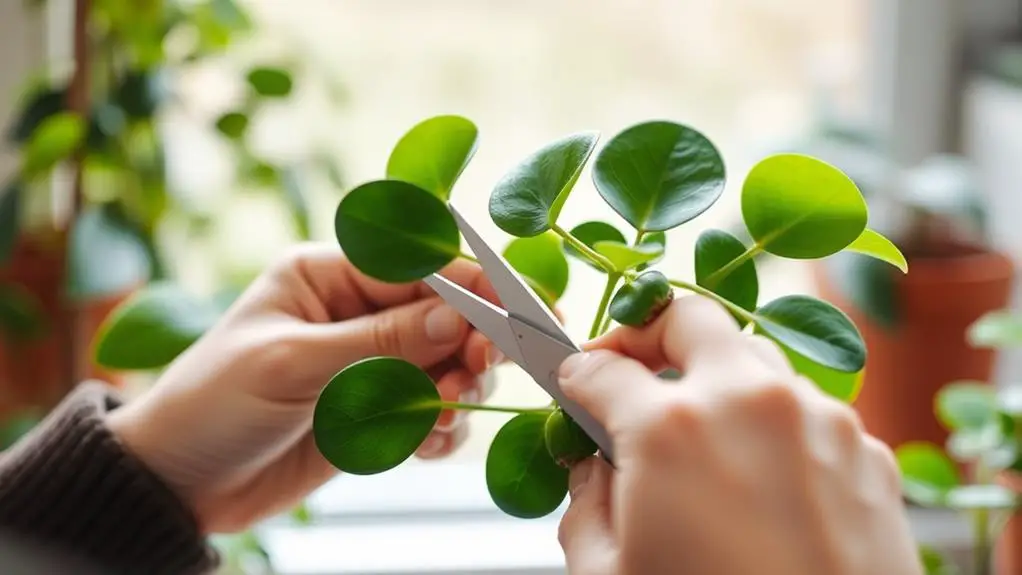
Pruning Peperomia Hope is an essential step in its care routine, especially during its active growth phase in spring or early summer. Regular pruning promotes healthy growth and keeps your plant looking its best. Start by removing any dead, yellowing, or damaged leaves at the base of the stem. This not only enhances the plant's appearance but also helps prevent diseases.
When you trim long, spindly stems, cut just above a leaf node to stimulate new growth. This encourages bushier growth and makes your plant fuller. If you notice flower spikes, consider pruning them off. This redirects the plant's energy back into the foliage rather than flower production, ensuring a greener and healthier appearance.
Always use clean, sharp scissors or pruning shears for cutting. This minimizes the risk of introducing disease to your Peperomia Hope.
| Task | Purpose |
|---|---|
| Remove dead leaves | Prevent diseases, enhance appearance |
| Trim long stems | Encourage bushier growth, stimulate new growth |
| Prune flower spikes | Redirect energy to foliage |
Propagation Methods
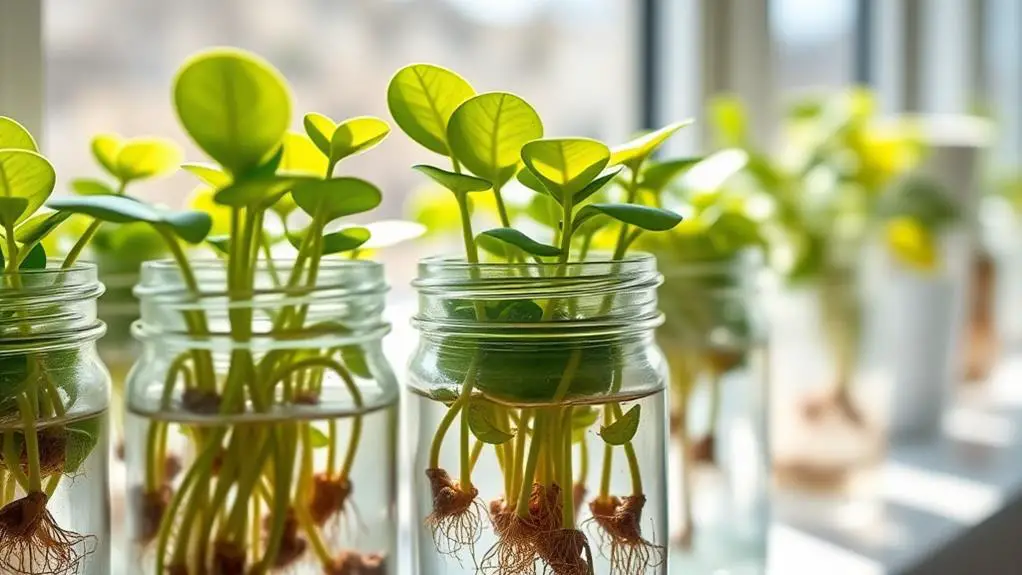
When it comes to propagating Peperomia Hope, you have a few reliable methods to choose from. These propagation methods will help you expand your Peperomia collection effectively.
- Stem Cuttings: Take a healthy stem with 2-3 nodes. Let the cut end callus for 1-2 days. Then, plant it in well-draining soil or place it in water. Keep the soil slightly moist to support root development.
- Leaf Cuttings: Press a leaf cutting into pre-moistened soil. This method takes longer than stem cuttings but can be equally rewarding. Make sure the soil stays slightly moist to encourage root growth.
- Water Propagation: You can also root stem cuttings in water. Change the water every few days to keep it fresh. Once roots are 2-3 inches long, transplant the cutting into well-draining soil.
- Small Pups: Occasionally, small pups sprout from the base of leaves. This method is slower and requires patience for growth. However, it's gratifying to see new plants emerge this way.
With these methods, you'll find that propagating Peperomia Hope is both simple and rewarding.
Just remember to be patient and keep the soil moist to guarantee successful root development. Happy gardening!
Pest Management
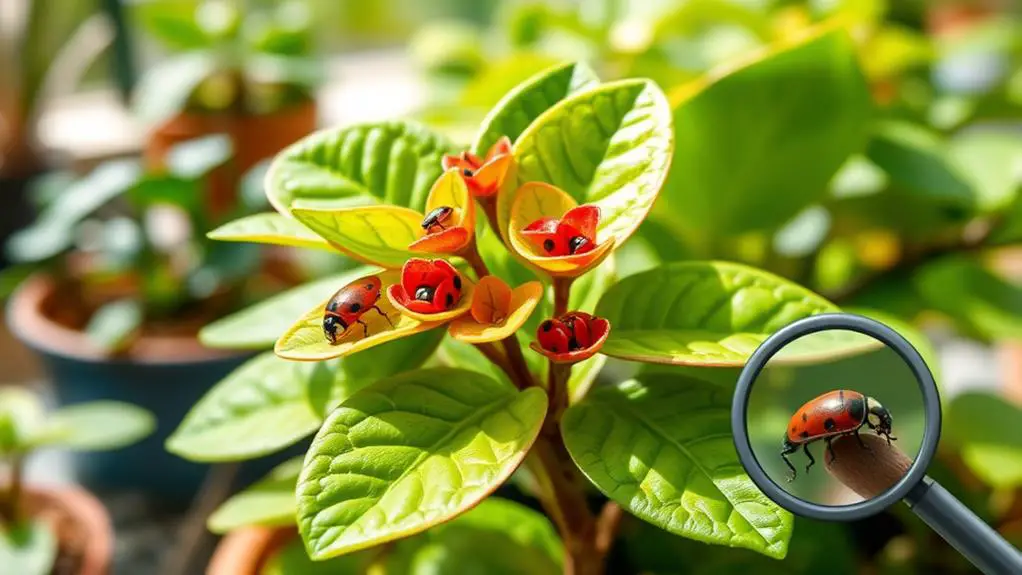
Keeping your Peperomia Hope pest-free is vital for its health and vigor. Regularly inspect your plant for pests like mealybugs, spider mites, and scale. These pests often appear as white cotton-like clusters or sticky residue on leaves and stems. Early detection helps you manage infestations before they harm your plant.
To reduce the risk of pests, guarantee good airflow around your Peperomia Hope. Avoid overly humid or stagnant conditions. If you do find pests, treat them effectively. Use a Q-tip dipped in rubbing alcohol to remove mealybugs or apply insecticidal soap for broader infestations.
| Pest | Identification | Treatment |
|---|---|---|
| Mealybugs | White cotton-like clusters | Rubbing alcohol on a Q-tip |
| Spider Mites | Tiny webs or speckled leaves | Insecticidal soap |
| Scale | Brown, shell-like bumps | Insecticidal soap or rubbing alcohol |
Proper care is vital. A healthy plant is less susceptible to pests. If you notice yellowing or curling leaves, check for pests and adjust your watering or light conditions. These can be signs of stress or infestation. By keeping a close eye on your Peperomia Hope and providing the right care, you'll guarantee it stays vibrant and pest-free.
Frequently Asked Questions
How to Take Care of Peperomia Hope?
Place Peperomia Hope in bright, indirect light, about a meter from south or west-facing windows. Water when the top 1-3 inches of soil are dry. Keep temperatures between 65-80°F and humidity at 40-60%. Fertilize monthly.
How Do You Keep Peperomia Healthy?
To keep your Peperomia healthy, give it bright, indirect light, water when the top soil dries, maintain 65°F to 80°F, and fertilize monthly in growing season. Regularly check for pests and avoid temperature extremes.
How Do You Make Peperomia Hope Fuller?
To make your Peperomia Hope fuller, regularly prune leggy stems and remove dead leaves. Propagate stem cuttings and guarantee bright, indirect light. Fertilize monthly during the growing season and group with other plants for added humidity.
How Often Should I Water My Hope Plant?
You should water your Peperomia Hope every 1-2 weeks during spring and summer when the top 1-3 inches of soil are dry. In winter, reduce watering to less than once a month as the plant's needs decrease.
Conclusion
You've got this! By following these seven steps, your Peperomia Hope will thrive and bring joy to your space. Remember, provide the right light, water carefully, use good soil, and keep an eye on temperature and humidity. Don't forget to prune and watch for pests. With a bit of effort, you'll see your plant flourish. Keep practicing, and your gardening skills will grow too. Happy planting!

